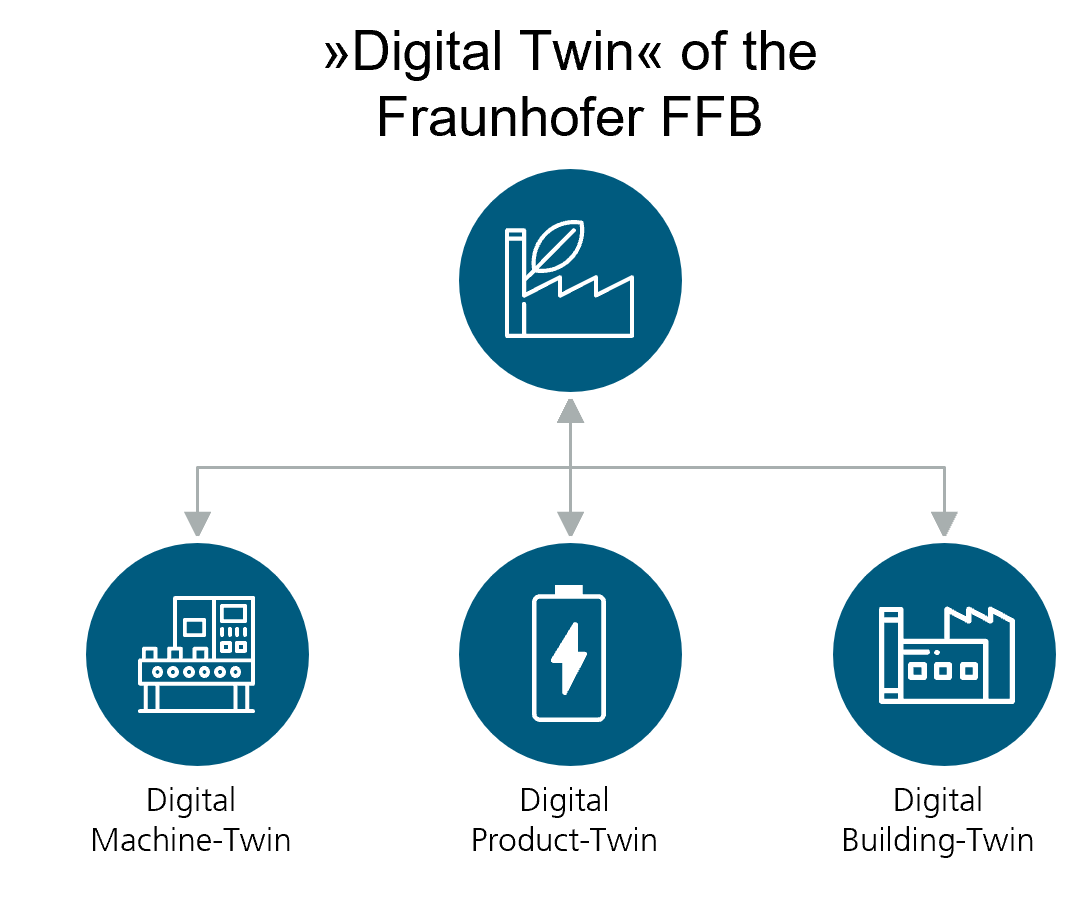Digital twins in battery cell production
Münster. The white paper "The Digital Twin in Battery Cell Manufacturing" has been published. It focuses on the use and potential digital twins can unleash in various areas of battery cell manufacturing. Together with eight other leading research institutions from the "FoFeBat" project, the concept of digital twins for battery cell manufacturing was developed. This distinguishes between the digital plant twin, the digital product twin, and the digital building twin. The current white paper describes the practical implementation of the concept at the Fraunhofer Research Institution for battery cell production FFB.

Digital twins are representations of physical objects that are enriched with data, information, and models over the respective life cycle in the production process. As digitized images, they can be continuously updated, improved, and expanded by sensor data. The first digital twins were developed by NASA as early as the 1970s to identify problems and solutions for spacecraft. The integration of a physical object into the virtual representation enables the simulation and visualization of production processes from start to finish. This allows companies to monitor and analyze strategies live, enabling them to identify problems and make process optimizations more quickly. Aligned with the goals pursued, digital images can be individually designed according to their area of application. Depending on requirements, data analysis is used, for example, for description, diagnosis, traceability, prediction, or recommendation.
The white paper explains the different definitions of the term in the scientific discourse. The aim is to achieve a uniform, more universally valid understanding of the term for the digital twin of battery cell production.
Here, digitization holds great advantages in store. A look at the battery market makes it clear that demand for lithium-ion battery cells will continue to rise in the coming years. One reason for this is the transformation of the mobility industry and the associated growing expansion of electromobility, as is made clear in the Environment Report on the European Battery Innovation System 2022. Accordingly, battery factories are being set up in Europe that has to meet the high requirements for quality, sustainability, and process stability. These will be standardized by political regulations, such as the "Battery Passport", in order to be able to comprehensively describe the responsibilities in the supply chain. A digital twin can help to achieve higher quality at this point, as it reveals weak points in production, accelerates process optimization, and makes solutions such as the "Battery Passport" possible in the first place. So far, there is no digital twin of a complete battery cell production that includes the factory building, the production machines, and the product.
One twin per physical instance: product twin, plant twin, building twin
Despite all the advantages, implementing Digital Twins in battery cell manufacturing turns out to be no easy task, as there are a large number of physical objects that need to be connected. Answers to this challenge are provided by the concept presented in the white paper. It distinguishes between three types of digital twins: Plant Twin, Product Twin, and Building Twin. The Digital Twin of Battery Cell Manufacturing brings these together holistically, and its tripartite, modular structure enables easier manageability and the exchange of data and information at the technical level. But what function do the twin modules perform in detail?
The plant twin digitizes all processes of the production equipment in the factory. As a result, the condition of machines can be monitored and decisions made based on this, reducing their wear and tear and shortening maintenance times. The efficiency of the plant is increased because the data can be viewed coherently. This leads to more economical and ecological production.
In contrast to the plant twin, the product twin collects all data and characteristics of raw materials as well as intermediate and end products, including the parameters of the processing operations. Thus, a digital representation of the product configuration is generated, which can be enriched and linked with data on external environmental factors and relevant process data.
The digital building twin increases the efficiency of factory building design through the use of Building Information Modeling (BIM) and the digital representation of the building used in all phases of construction and operation. The increase in efficiency consequently reduces costs and CO2 emissions. It also contributes to transparent communication between the partners involved in the construction project.
The different twins allow overarching knowledge gains and optimizations through their interaction. Thus, influences of plant parameters on battery cell properties can be precisely described and used, while the properties during operation of the building on the parameters and process quality of the plants can be represented. Through this overarching view, battery cell production is digitally mapped both in-depth and across the board.
The networking of the individual forms of expression of the digital twin of battery cell production makes the energy requirement and product quality tangible in figures so that innovation potential can be identified more quickly. The conceptual design of the individual digital twins for Fraunhofer FFB's "FFB PreFab" and "FFB Fab" will create the fundamental conditions for an ecological and economical factory.
If you are interested in downloading the paper, please click here.
Last modified: